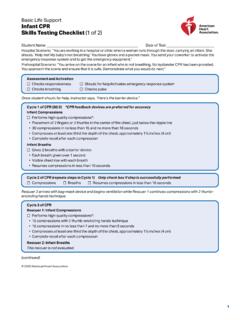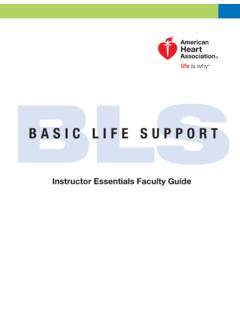Transcription of Faculty Guide for BLS and Heartsaver Instructor Courses
1 2006 American Heart Association Faculty Guide for BLS and Heartsaver Instructor Courses 2006 American Heart Association 2 Contents Part 1: Preparing for the Course .. 3 Course Objectives and Competencies .. 4 Course Audience and 4 Educational Design .. 5 Faculty Needs .. 5 Attendance 6 Course Planning Checklist and Timeline .. 6 TC Faculty Course Support Materials .. 10 Part 2: Teaching the Course .. 13 Using Lesson 14 Cleaning 15 BLS Instructor Course Outline .. 16 Heartsaver Instructor Course 18 Part 3: Renewal .. 20 Part 4: Lesson Maps .. 21 BLS Instructor Course Lesson Maps .. 21 Heartsaver Instructor Course Lesson 46 Appendix: Instructor Competency Checklist .. 69 2006 American Heart Association 3 Part 1: Preparing for the Course 2006 American Heart Association 4 Course Objectives and Competencies Introduction This manual is to be used by BLS Regional Faculty and Training Center Faculty to conduct the BLS Instructor Course and the Heartsaver Instructor Course.
2 Both of these Courses are classroom based and are open to Instructor candidates who have met the admission criteria. Course Goal The American Heart Association designed the BLS Instructor Course and Heartsaver Instructor Course to prepare people to become Basic Life Support (BLS) or Heartsaver instructors. Objectives At the end of the BLS Instructor Course or Heartsaver Instructor Course, Instructor candidates will be able to teach a BLS course using the video and lesson maps that are part of the appropriate BLS course Instructor materials. Instructor candidates will also be able to use the new testing materials to conduct skills testing. Exit Criteria Successful completion of each Instructor course consists of Instructor candidates facilitating a session where they Instruct a group on practice-while-watching the video Successfully evaluate another Instructor candidate while correctly using the skills testing checklist Successfully remediate another Instructor candidate The Training Center (TC) Faculty will use the American Heart Association Emergency Cardiovascular Care Instructor Competency Checklist found at the end of this manual.
3 This document serves as a Guide in assessing Instructor candidate proficiency in the AHA Core Course competencies during the practice session in the discipline-specific course. Not all competencies can be assessed in a single Instructor candidate demonstration. Course Audience and Prerequisites Who Can Take the Course Anyone who wants to become an AHA ECC BLS or Heartsaver Instructor can take this course. The ideal candidate will be motivated to Teach Facilitate learning Ensure that providers acquire the skills necessary for successful course completion View provider assessment as a way to improve individual knowledge and skills 2006 American Heart Association 5 Course Prerequisites Prospective instructors must Have completed the AHA Core Instructor Course Be aligned with an AHA TC Those entering the BLS Instructor Course must have current AHA Healthcare Provider status. Non-healthcare professionals must also have current first aid status.
4 Those entering the Heartsaver Instructor Course must have current status in any combination of Courses that provide the following skills : Adult/child CPR, AED, mask use, and choking infant CPR, mask use, and choking First aid Educational Design Lesson-Based and Video- Based Structure The BLS and Heartsaver Instructor Courses are video-based. They are divided into multiple lessons. Some of the CPR lessons are practice-while-watching lessons during which students practice skills as the video guides them. The video instruction shapes the course. It defines course content and skills practice intervals and provides consistent instruction to every student in every class. It should help Training Center Faculty maintain a tight schedule and a carefully integrated curriculum. This instructional design maximizes skills practice and learning. Practice While Watching The BLS Instructor Course and Heartsaver Instructor Course are Instructor -led, using video to Guide practice.
5 Immediate TCF feedback during skills practice enhances learning. Faculty Needs Who Can Teach the Course Any current AHA BLS TC or Regional Faculty member may teach the BLS or Heartsaver Instructor Course. TC Faculty -to-Student Ratio The size for each BLS Instructor Course or Heartsaver Instructor Course is flexible, and there is currently no research-based best Instructor -to-student ratio. The practice lessons of the course, however, are designed to use a 2006 American Heart Association 6 ratio of 8 students to 2 manikins to 1 TC Faculty . This will create 2 groups of 4 students. During practice and role-playing sessions, 1 Instructor candidate in each group will play the role of Instructor and the other 3 will play the role of students. Attendance Requirements Attendance Requirements Instructor candidates must successfully complete the entire course to be eligible to be monitored as a new Instructor .
6 An Instructor card is issued only after successful monitoring. Once candidates are certified as instructors, they should be encouraged to join the AHA Instructor Network. The Instructor Network is an online resource offering a free one-stop-shop for access to Instructor and TC Coordinator information, bulletins, and memos, networking and educational opportunities, and much more. Course Planning Checklist and Timeline Notifying ECC Service Center of Pending Course To provide better customer service, the TC should submit a list of planned Instructor Courses that are open to the public to their AHA Service Center. The list should include course dates, location, and contact person for registration. The Service Center will make this information available to people seeking course information. Ordering Materials To help in the distribution of ECC materials, the AHA has partnered with several companies that provide high-quality customer service and support.
7 To order materials contact one of the companies listed on the back cover of any ECC book or visit the ECC website at Instructors can directly order books or support materials from any of the AHA distributors. Only a TC Coordinator can order cards. Room Requirements You can teach an average Instructor course of 16 Instructor candidates with 2 TC Faculty in 1 large room. The room should comfortably accommodate the students with open space at the front of the classroom for manikins, students, chairs, tables, and room to move around easily. The room should have Good acoustics Good lighting that can be dimmed or adjusted for video presentations An Instructor -controlled video player (DVD or VCR) and monitor large 2006 American Heart Association 7 enough to be viewed by all students. (Although a TV may be acceptable for small classes with only a few groups, larger classes with several manikins may require a large-screen TV or a TV projector.)
8 See the sample floor plan on the next page.) Ideally, carpeted floors for skills practice A chair for each student 2006 American Heart Association 8 Sample Floor Plan The following picture shows a sample floor plan: Sample Precourse Letter to Instructor Candidates The letter on the following page is a sample you may modify and send to Instructor candidates. 2006 American Heart Association 9 Sample Precourse Letter to Instructor Candidates (Date) Dear Instructor Course Candidate: Welcome to the Instructor Course. When and Where The class will be Date: Time: Location: Please plan to be on time because it will be hard for late students to catch up once we start. How to Get Ready The Instructor Course covers a lot of material in a short time. Please bring your Instructor Manual(s) and lesson maps with you to class.
9 This will help you learn more during the course and make you more comfortable with the material. What to Wear Please wear loose, comfortable clothing. You will be practicing skills that require working on your hands and knees, bending, standing, and lifting. If you have any physical conditions that might prevent these activities, please tell one of the instructors. The Instructor may be able to adjust the equipment if you have back, knee, or hip problems. Also please tell your Instructor if you are allergic to latex. We look forward to welcoming you on __ (day and date of class)_____. If you have any questions about the course, please call ____(name)_____ at __(telephone number)_____. Sincerely, (Title) 2006 American Heart Association 10 TC Faculty Course Support Materials TC Faculty Materials TC Faculty materials available for teaching these Courses include the following: Item Description Use TC Faculty Guide for BLS and Heartsaver Instructor Courses Text with information about how to teach the BLS Instructor Course and the Heartsaver Instructor Course.
10 Available on the Instructor Network. Review before class to understand your role and the necessary equipment BLS/ Heartsaver Instructor Course DVDs Basic Life Support skills Testing Training Video 2006 BLS Rollout video titled: 2006 Guidelines Rollouts Materials Training Videos* Review before class to understand the videos Show during class * Note: the 2006 Guidelines Materials Training Videos had a mislabeling for the first print run provided to TCs. Check the actual video before using it in class. Lesson maps Cards with information about what each lesson includes Review before class to understand your role and the necessary equipment Refer to these during the course to know what each lesson includes and what you need to do to help the students meet their learning objectives for each lesson Instructor manuals and videos for all BLS Courses Manuals and videos (DVD or VHS format)

